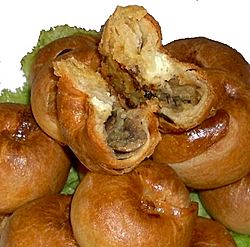Knish facts for kids

Knishes with mashed potato and fried onions
|
|
| Alternative names | Knysh |
|---|---|
| Type | Snack, side dish, finger food |
| Region or state | United States, Israel , other countries with a significant remaining Ashkenazi Jewish population |
| Created by | Jewish communities in Central and Eastern Europe |
| Main ingredients | Mashed potatoes, dough, ground meat, sauerkraut, onions, kasha, cheese |
A knish is a traditional Ashkenazi Jewish snack food consisting of a filling covered with dough that is typically baked or sometimes deep fried.
Knishes are usually purchased from street vendors in urban areas with a large Jewish population, sometimes at a hot dog stand or from a butcher shop. It is still strongly associated with New York City, the New York City region, and New York City cuisine. It was made popular in North America by Ashkenazi Jewish refugees from the Pale of Settlement (mainly from present-day Belarus, Lithuania, Ukraine, and eastern Poland).
In most traditional versions, the filling is made entirely of mashed potato, kasha (buckwheat groats), or cheese. Other varieties of fillings include sweet potatoes, black beans, or spinach.
Knishes may be round, rectangular, or square. They may be entirely covered in dough or some of the filling may peek out of the top. Sizes range from those that can be eaten in a single bite hors d'oeuvre to sandwich-sized.
History in the United States
Ashkenazi Jewish immigrants who arrived sometime around 1900 brought knishes to the United States. Knish (קניש) is a Yiddish word that was derived from the Ukrainian knysh (книш) and Polish knysz. The first knish bakery in America was founded in New York City in 1910. Generally recognized as a food made popular in New York City by Jewish immigrants in the early 20th century, the United States underwent a knish renaissance in the 2000s driven by knish specialty establishments such as the Knish Shop in Baltimore, Maryland, Buffalo and Bergen in Washington, DC, or My Mother's Knish, in Westlake Village, California.
In the 20th century New York City and state politicians portrayed themselves eating knishes to show solidarity with Jewish working class people. The trend declined after suburbanization and the policies of Ed Koch and Rudy Giuliani made policies that restricted the sale of knishes from food carts.
See also
 In Spanish: Knish para niños
In Spanish: Knish para niños

